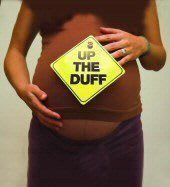Lisa Evans's new play about four pregnant women taking antenatal classes with midwife Sheila will not be to everybody's taste, though it is a successful production with some joyful moments of comedy. Although York Theatre Royal's Artistic Director (and director of this show) Damian Cruden has worked hard at selling the show to a wide cross-section of the community, his latest directorial outing should really be seen as a perfect pre-panto winter warmer, recommended for audiences of mums, mums-to-be, and girls on works night out.
This demographic did seem to constitute a large portion of the audience in the theatre last night - and a good night out was clearly to be had. Gleeful cackles of recognition welcomed the play's opening scene, which ticked all the basic comedy boxes to do with the stereotypical pregnant woman. Thus we saw the working woman uncharacteristically losing it while scrambling through her bottomless bag for a pen; the brassy hairdresser complaining of her recent loss of spatial awareness while missing the coat hook by a considerable distance; and at the other end of the process, the menopausal midwife turning the thermostat down. On the surface, Up the Duff offers little beyond a sitcom-esque set-up and series of revelations and gags. But it is impossible not to recognise that it's staged with aplomb and performed well by a cast which is clearly working together with relish and ease.
There is also an impressive set, incorporating realistic clinic walls which fade, through imaginative use of gauze, to provide a stunning reveal of the play's second main location. The scaffolding beyond also allows the simple but fantastically effective positioning of cast members as the ensemble covers scene changes (and evoke an atmosphere) with a series of stylish cover versions of 60s pop hits. Designer Helen Fownes-Davies has come up with a winning set, coupled with the impressive lighting design by Richard G Jones (though the glitter ball is perhaps a step too far into kitsch for some tastes).
Though this is a light entertainment, with visual gags about babies, nappies, pelvises and placentas aplenty, there is a drive behind the play which explores a far more interesting set of impulses than the fairly lowest-common denominator comedy. This is particularly true of the moving scene - placed, significantly, just after the interval - in which Sheila (Sarah Parks) recounts the human trauma behind a stressful (and faceless) hospital enquiry into her department.
It's also a shame that when Sheila's accident-prone husband Graham (a loveable and unselfish performance from Colin Tarrant) opens his own heart in what is, on the page, a touching development of his character and a hint at the sadness that underpins his plethora of DIY-based displacement activity, it's entirely upstaged by Teresa's (Kali Peacock) attempts to disguise the fact that she's just peed in a bucket. This is not to criticise Peacock, who consistently extracts the maximum comedy from her role, with the precision and control of a master comic actor, but to point out that the play itself repeatedly favours uproarious laughter over the darkness which is hinted at beneath the surface.
Thus while the conclusion of the play brings hope for the future, it is only by somewhat hurriedly brushing past Sheila's real sense of melt-down and loss, by ignoring the breakdown of Teresa's relationship, and by making working mum-to-be Roshin commit to a life of childcare (for the foreseeable future at least). Perhaps, though, this is unfairly enforcing a social realist reading on the play, when the point it's really making is that "children change your life", both when they arrive and when they go away.
